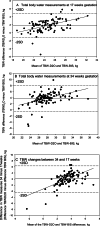Gains in body mass and body water in pregnancy and relationships to birth weight of offspring in rural and urban Pune, India
- PMID: 36304819
- PMCID: PMC9554425
- DOI: 10.1017/jns.2022.75
Gains in body mass and body water in pregnancy and relationships to birth weight of offspring in rural and urban Pune, India
Abstract
Maternal size, weight gain in pregnancy, fetal gender, environment and gestational age are known determinants of birth weight. It is not clear which component of maternal weight or gained weight during pregnancy influences birth weight. We evaluated the association of maternal total body water measured by the deuterium dilution technique (TBW-D2O) at 17 and 34 weeks of gestation with birth weight. A secondary aim was to examine the utility of bioimpedance spectroscopy (BIS) to determine total body water (TBW-BIS) in pregnancy. At 17 and 34 weeks of pregnancy, ninety-nine women (fifty-one rural and forty-eight urban) from Pune, India had measurements of body weight, TBW-D2O, TBW-BIS and offspring birth weight. At 17 weeks of gestation, average weights for rural and urban women were 45⋅5 ± 4⋅8 (sd) and 50⋅7 ± 7⋅8 kg (P < 0⋅0001), respectively. Maternal weight gains over the subsequent 17 weeks for rural and urban women were 6⋅0 ± 2⋅2 and 7⋅5 ± 2⋅8 kg (P = 0⋅003) and water gains were 4⋅0 ± 2⋅4 and 4⋅8 ± 2⋅8 kg (P = 0⋅092), respectively. In both rural and urban women, birth weight was positively, and independently, associated with gestation and parity. Only for rural women, between 17 and 34 weeks, was an increase in dry mass (weight minus TBW-D2O) or a decrease in TBW-D2O as a percentage of total weight associated with a higher birth weight. At both 17 and 34 weeks, TBW-BIS increasingly underestimated TBW-D2O as the water space increased. Differences in body composition during pregnancy between rural and urban environments and possible impacts of nutrition transition on maternal body composition and fetal growth were demonstrated.
Keywords: BIS, bioimpedance spectroscopy; Bioimpedance spectroscopy; Birth weight; Body water by deuterium dilution; D2O, deuterated water; GWG, gestational weight gain; KEMH, King Edward Memorial Hospital; Nutrition transition; Pregnancy; SLI, standard of living index; TBW, total body water..
© The Author(s) 2022.
Figures

Similar articles
-
Impact of changes in maternal body composition on birth weight and neonatal fat mass in dichorionic twin pregnancies.Am J Clin Nutr. 2018 Oct 1;108(4):716-721. doi: 10.1093/ajcn/nqy180. Am J Clin Nutr. 2018. PMID: 30321273
-
Relationship between maternal body composition during pregnancy and infant's birth weight in Nairobi informal settlements, Kenya.BMJ Nutr Prev Health. 2020 Jul 23;3(2):151-161. doi: 10.1136/bmjnph-2019-000060. eCollection 2020 Dec. BMJ Nutr Prev Health. 2020. PMID: 33521524 Free PMC article.
-
Maternal weight and body composition during pregnancy are associated with placental and birth weight in rural Bangladesh.J Nutr. 2012 Nov;142(11):2010-6. doi: 10.3945/jn.112.163634. Epub 2012 Sep 18. J Nutr. 2012. PMID: 22990469 Free PMC article. Clinical Trial.
-
Offspring body size and metabolic profile - effects of lifestyle intervention in obese pregnant women.Dan Med J. 2014 Jul;61(7):B4893. Dan Med J. 2014. PMID: 25123127 Review.
-
Body fluid volumes measurements by impedance: A review of bioimpedance spectroscopy (BIS) and bioimpedance analysis (BIA) methods.Med Eng Phys. 2008 Dec;30(10):1257-69. doi: 10.1016/j.medengphy.2008.06.009. Epub 2008 Aug 3. Med Eng Phys. 2008. PMID: 18676172 Review.
Cited by
-
Exploring fetal growth patterns in the second trimester: insights from ultrasound measurements among the Minangkabau Ethnic Group in Indonesia.BMC Pregnancy Childbirth. 2025 Jan 24;25(1):68. doi: 10.1186/s12884-024-07042-5. BMC Pregnancy Childbirth. 2025. PMID: 39856642 Free PMC article.
-
Anthropometric Measurements and Laboratory Methods for Pregnancy: An Update Review to Evaluation of Body Composition.Curr Nutr Rep. 2025 Jan 8;14(1):13. doi: 10.1007/s13668-024-00597-x. Curr Nutr Rep. 2025. PMID: 39776373 Free PMC article. Review.
References
Publication types
MeSH terms
Substances
LinkOut - more resources
Full Text Sources
Miscellaneous

